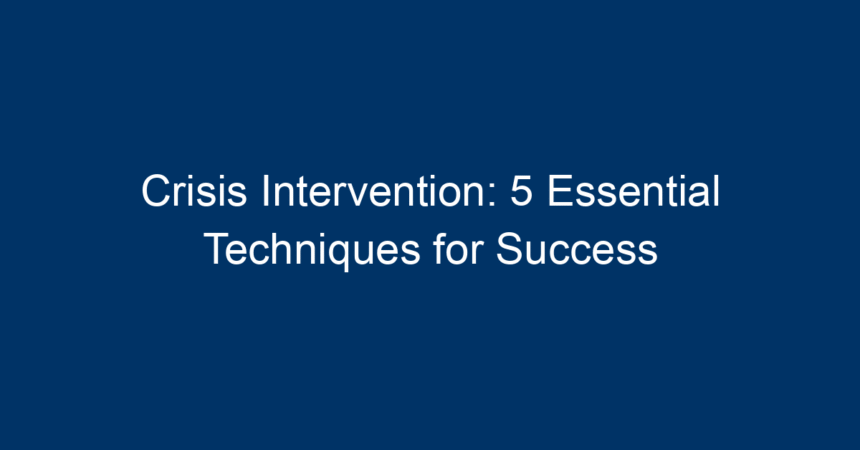In today’s fast-paced world, crises can arise unexpectedly in a variety of settings, from workplaces to schools and even at home. Crisis intervention is a crucial skill set designed to help individuals navigate through such challenging situations effectively. Whether you’re a mental health professional, a community leader, or simply someone looking to be a pillar of support, knowing key crisis intervention techniques can enhance your ability to respond compassionately and effectively. In this article, we’ll explore five essential techniques for successful crisis intervention that can empower you to help others in their most challenging moments.
Understanding Crisis Intervention
Before diving into the techniques, it’s important to clarify what crisis intervention entails. In essence, crisis intervention aims to provide immediate, short-term assistance to individuals in distress, helping them regain control and stabilize their situation. It’s not a long-term therapy solution but rather a means to guide individuals toward resilience and recovery during emotional or psychological upheaval.
Effective crisis intervention can lead to improved emotional well-being, reduced anxiety, and better coping strategies. Understanding the core principles of crisis intervention helps in selecting the most appropriate techniques based on individual needs.
1. Active Listening
Active listening is one of the most fundamental and powerful techniques in crisis intervention. It involves fully focusing, responding, and understanding what the individual in crisis is expressing.
Why It Matters
Active listening builds rapport and trust, allowing the distressed person to feel heard and valued. This technique goes beyond just hearing words; it involves interpreting non-verbal cues and emotional undertones. By doing so, you can gain deeper insights into the individual’s feelings and needs.
How to Implement Active Listening
- Maintain Eye Contact: This shows that you are engaged and present in the conversation.
- Use Verbal Acknowledgments: Simple phrases like "I understand" or "That sounds really tough" validate their experience.
- Reflect Back: Paraphrase what the individual has said to demonstrate your understanding.
Incorporating active listening into your crisis intervention toolkit can substantially improve the quality of your interaction with those in distress.
2. Establishing Safety
In any crisis situation, establishing safety is paramount. Individuals in crisis may perceive threats even if no actual danger is present, so addressing their safety needs can bring them a sense of peace and control.
Steps to Establish Safety
- Assess the Environment: Quickly evaluate the surroundings for any potential hazards.
- Reassure the Individual: Let them know that they are in a safe space and that you are there to help.
- Provide Options: Discuss practical steps that can be taken to ensure safety, like moving to a quieter location or contacting emergency services if necessary.
Creating a safe environment can significantly decrease anxiety and facilitate open communication.
3. Emotional Validation
Emotional validation is a crucial aspect of crisis intervention that often gets overlooked. It involves recognizing and affirming the feelings of the individual in crisis, regardless of whether those feelings make sense to you.
Why It’s Important
When individuals feel their emotions are validated, they are more likely to open up and engage in the intervention process. This technique fosters a sense of understanding and reduces feelings of isolation, which can be prevalent during a crisis.
How to Apply Emotional Validation
- Acknowledge Their Feelings: Say things like, "It makes sense that you feel this way given what you’re going through."
- Avoid Judging or Minimizing: Stay away from phrases such as "You shouldn’t feel that way"; instead, acknowledge their feelings as real and significant.
- Encourage Expression: Allow them to express their emotions freely, offering them the space to do so without fear of judgment.
Utilizing emotional validation helps create a supportive atmosphere that empowers individuals to share and process their experiences.
4. Solution-Focused Approach
While it’s vital to acknowledge emotions, a solution-focused approach can help individuals move from crisis to resolution. This technique encourages individuals to identify problem-solving strategies and reinforces their strengths.
Steps for a Solution-Focused Approach
- Identify Goals: Ask the individual what they would like to achieve during the conversation. This helps them focus on potential outcomes rather than solely on their problems.
- Explore Resources: Discuss skills, experiences, and social supports they can call upon in their time of need. Reinforcing their resilience can boost confidence.
- Encourage Small Steps: Help them break down larger goals into manageable, actionable steps.
This approach not only alleviates feelings of helplessness but also empowers individuals to take charge of their situation.
5. Follow-Up Support
Crisis intervention doesn’t end once the immediate situation is stabilized. Follow-up is crucial for building long-term resilience and emotional health.
Importance of Follow-Up Support
Many people may still be dealing with the after-effects of a crisis days, weeks, or even months later. Effective follow-up can include check-ins, resource referrals, and offering ongoing support.
Best Practices for Follow-Up
- Schedule Check-Ins: Regular calls or messages can provide continued emotional support and remind individuals that they are not alone.
- Provide Resources: Share information on local support groups, counseling services, or hotlines.
- Encourage Self-Care: Promote activities that can help in maintaining mental well-being, such as exercise, mindfulness, or hobbies.
By ensuring consistent support, you can significantly enhance the recovery process for individuals who have experienced a crisis.
Conclusion
Crisis intervention is an essential skill that can make a significant difference in people’s lives during their most challenging times. By mastering these five techniques—active listening, establishing safety, emotional validation, a solution-focused approach, and follow-up support—you can empower individuals to navigate their crises more effectively.
Remember, every situation is unique, and these techniques can be adjusted based on the context and the individual’s needs. The ultimate goal is to offer compassionate support and guide them toward recovery and resilience.
Take action today: educate yourself further on crisis intervention techniques, engage in role-playing scenarios, or even pursue training courses. The better equipped you are, the more effectively you can assist others in times of need. Your ability to intervene during a crisis can be a transformative experience—not just for the individuals involved but also for yourself as a compassionate ally in their journey toward healing.




